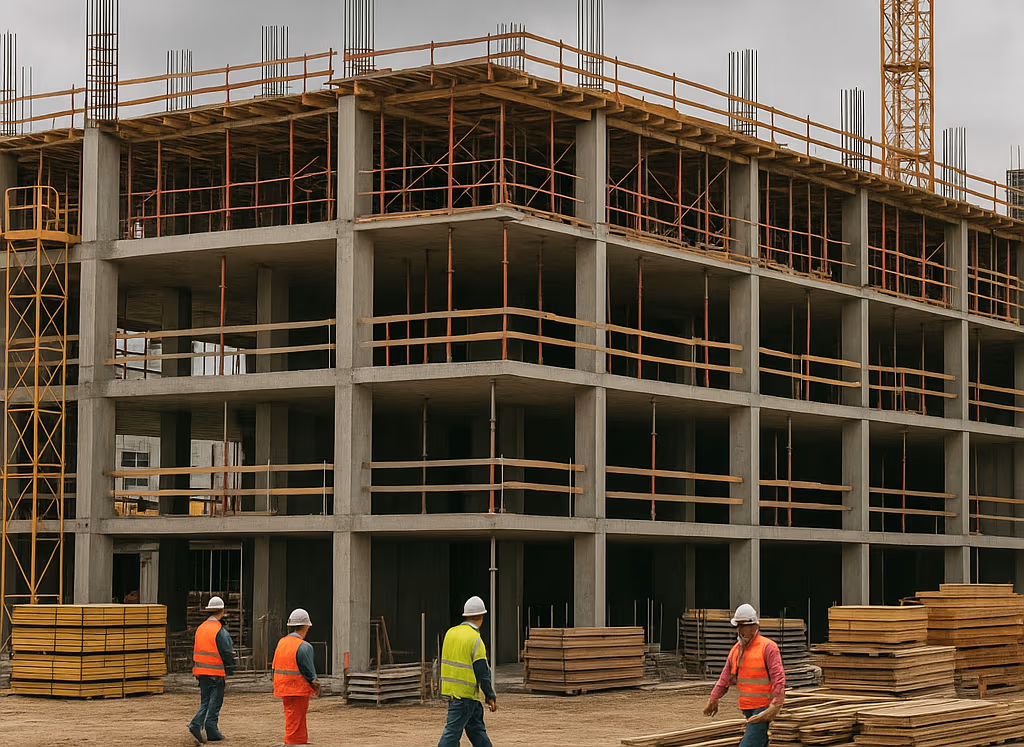Hospital Construction Requirements in India (2025)

Table of content
Designing a hospital in India in 2025 isn’t just about floor plans—it’s about navigating a compliance maze. Every corridor width, stair dimension, or HVAC pressure gradient is tied to a cited standard. The NABH 6th Edition (effective Jan 1, 2025) introduces 639 objective elements, including 105 core elements across patient safety, Facility Management & Safety (FMS), and Infection Prevention & Control (IPC) . Meanwhile, the National Building Code (NBC) 2016 Part-4 (Fire & Life Safety) classifies hospitals under Institutional Occupancy C-1 and mandates strict fire zoning, egress widths, and firefighting installations .
Did you know? Nearly 30% of hospital projects face delays due to non-compliance with NBC Part-4 Table-7 (fire tanks, pumps, sprinklers) and missed NABH FMS/IPC design provisions—often requiring costly retrofits at commissioning.
The fastest way to keep your hospital project on track is to design with NBC clauses and NABH checklists embedded in your drawings from day one.
How to build a patient centric hospital in India
NABH 6th Edition (Hospitals) provides the quality & safety framework for accreditation. Chapters impacting construction:
- Facility Management & Safety (FMS): asset registers, statutory compliance, risk registers (Clause FMS.3, NABH 6th Ed.)
- Infection Prevention & Control (IPC): zoning, pressure cascades, sterile flows (Clause IPC.2, NABH 6th Ed.)
- Emergency Preparedness: designated triage areas, evacuation maps (Clause FMS.6, NABH 6th Ed.)
Example Case: A 150-bed hospital in Delhi failed its first NABH audit because soiled and sterile corridors overlapped. Rectification required ₹1.2 Cr in retrofits—avoidable if IPC zoning had been mapped in design.
Hospitals fall under Institutional Occupancy – Group C, Sub-division C-1 (Hospitals & Sanatoria) per NBC 2016 Part-4, Clause 3.1.7.1.
Core prescriptions with citations:
- Staircase width: Min 2.0 m for institutional buildings (NBC Part-4, Table 7, Clause 4.7.2).
- Dead-end corridors: ≤ 6 m (NBC Part-4, Clause 4.5.1); > 6 m only if fully sprinklered.
- Sprinklers & hydrants: Mandatory for hospitals >15 m height or >1000 m² floor plate (NBC Part-4, Table-7).
- Fire tank sizing: Min 100,000 L UG + 20,000 L terrace tank (NBC Part-4, Annex C, Table C-1).
- Pump pressure: Maintain 3.5 kg/cm² at the most remote hydrant (NBC Part-4, Annex C, Clause C.1.5).
Getting master planning right is the foundation for smooth statutory approvals and NABH accreditation. Authorities don’t just check FAR or setbacks—they evaluate emergency access, zoning flows, and compliance with NBC & NABH clauses.
Access & Circulation
- Fire tender movement: Provide an all-round driveway with a minimum 9 m turning radius so fire appliances can reach hydrants and entrances (NBC Part-4, Clause 3.4.6).
- Emergency access routes: Hardscape widths and gradients must accommodate ambulances and crash carts without bottlenecks.
Vertical Zoning & Refuge Areas
- Refuge spaces: Every 24 m of vertical rise, hospitals must provide a refuge area to serve as a safe assembly point during emergencies (NBC Part-4, Clause 4.12.3).
- Patient safety: These zones reduce evacuation risk in high-rise hospitals and are explicitly checked during Fire NOC reviews.
Functional Zoning & IPC Alignment
- Clean vs dirty circulation: NABH IPC (Clause IPC.2a) requires strict separation of sterile and soiled pathways. In practice, this means:
- CSSD flows → Dirty → Clean → Sterile (unidirectional).
- OT complex layouts with sterile cores and interlocked doors.
- ICU placement adjacent to OT lifts for sterile supply chains.
Always stamp drawings with “Institutional Occupancy, Group-C, Sub-division C-1 (Hospitals & Sanatoria)”. Wrong classification is the #1 cause of Fire NOC rejection under NBC.
NABH 6th Edition’s Facility Management & Safety (FMS) chapter expects hospitals to not only have reliable engineering services but also maintain evidence logs, risk registers, and redundancy systems. Aligning design choices early saves expensive retrofits.
Power & Electrical Safety
- N+1 redundancy in transformers, DGs, UPS for critical care (FMS.4).
- Segregated critical & non-critical panels for easy load shedding.
- Emergency lighting & exit signages powered by UPS (NBC Part-4, Clause 4.8.5).
- Earthing & ESD flooring in OTs and ICUs (NABH FMS.5).
Medical Gas Systems (MGPS)
- Zone valves & alarms on each floor (FMS.5).
- Dual-source manifolds and bulk oxygen storage sized for at least 24–48 hours of autonomy.
- Automatic switchover between primary and secondary banks.
HVAC & BMS Integration
- Differential pressures & ACH logs auto-recorded for OTs/ICUs (IPC.3a).
- AHUs with HEPA filters for sterile zones; dedicated AHUs for isolation areas.
- BMS dashboards integrated with alarms for fire panels, tank levels, temperature, and humidity logs (FMS.6).
Water & Plumbing
- Separate potable & flushing lines to prevent cross-contamination.
- Hot water loops in OTs, CSSD, and ICUs.
- Effluent Treatment Plant (ETP) & Sewage Treatment Plant (STP) with PCB-mandated sampling points (BMW Rules 2016 + FMS.7).
- Legionella prevention protocols in cooling towers and hot water systems.
Fire Detection & Life Safety Systems (NBC + NABH FMS)
- Addressable fire detection systems integrated with BMS (NBC Part-4, Clause 6.1).
- Sprinklers, hydrants, hose reels, and extinguishers sized per NBC Table-7.
- Fire control room with mimic panel as mandated for high-rise hospitals (NBC Part-4, Clause 6.3.2).
NABH auditors cross-check engineering SOPs against statutory approvals—so ensure Fire NOC, PCB, AERB, and Electrical Inspectorate certificates are all tied to the facility management logbooks from Day 1.
Design drawings must align to NBC 2016 Part-4 (Fire & Life Safety) from day one—non-compliance here is the #1 cause of Fire NOC rejection.
Occupancy & Egress
- Classification: Hospitals = Institutional (Group C, Sub-division C-1) (NBC Clause 3.1.7.1).
- Staircases: Min 2.0 m width with fire-check doors, proper treads/risers, and handrails (NBC Clause 4.7.2).
- Corridors & exits: Dead ends ≤ 6 m (unless sprinklered), with illuminated signage and tactile/photo-luminescent cues (NBC Clause 4.5.1).
Compartmentation & Shafts
- Provide fire/smoke compartments by floor, fire-rated doors, protected shafts, and a dedicated fireman’s lift above height/area thresholds (NBC Clause 4.12.3).
Firefighting Installations (Table-7)
- Hospitals typically need hydrants, hose reels, wet risers, detection & alarm systems, and often automatic sprinklers. Confirm exact requirements against NBC Table-7.
Water Storage & Pumps
- UG + terrace fire tanks and main + standby + jockey pumps maintaining ≥ 3.5 kg/cm² at the most remote hydrant (NBC Annex C).
Always reference NBC Table-7 directly on your fire drawings—this is the quickest way to secure Fire NOC approval.
University Construction Cost in India
NABH Chapter on IPC dovetails with national IPC guidance—this impacts HVAC set-points, pressure cascades, and room programs. Key design moves: portal.nabh.co+1
- Air changes & pressure: OTs and sterile corridors positive; isolation rooms negative with ante-rooms; ICU/HDU pressure gradients to protect patients.
- Clean utility & dirty utility separation: dedicated soiled holding and sluice rooms; pass-through hatches where appropriate; CSSD with dirty → clean → sterile unidirectional flow.
- Hand hygiene & materials: sink counts in clinical areas, elbow/foot operated or sensor taps; finishes that withstand medical cleaning regimens.
- Statutory set: Key plans, occupancy statement (C-1 Hospital), fire tender movement, setbacks, FAR/coverage, sections with stair & lift cores, fire compartment plans, fire fighting schematics (hydrants, risers, sprinklers, pumps, tanks), detection & alarm layouts, refuge areas, and as-built updates. sehgaldoor
- NABH evidence (design-stage helpful): FMS policy index; risk register templates; asset register schema; preventive maintenance (PPM) calendar; emergency response & mock-drill plans; IPC zoning maps; HVAC DP/ACH schedule tables for OTs/ICUs/Isolation. portal.nabh.co
- IPC support docs: national IPC guidelines appended to HVAC design narrative (pressure cascades, ACH, filtration). National Centre for Disease Control
Hospital construction in India in 2025 demands more than just blueprints—it demands code compliance with NABH 6th Edition and NBC Part-4 (Fire & Life Safety) at every stage. From 2.0 m institutional stair widths (NBC Clause 4.7.2) to negative pressure isolation rooms (NABH IPC.2b), every technical detail decides whether your hospital secures accreditation, Fire NOC, and public trust.
At BuiltX, we specialize in delivering end-to-end hospital projects—from site master planning and NBC Part-4 fire safety drawings to NABH documentation and audit support. Whether you’re planning a multispecialty hospital in Delhi, a medical college in Assam, or a community health center in Mumbai, BuiltX ensures your project is safe, compliant, and patient-centric from day one.
Connect with BuiltX to discuss how we can turn your healthcare vision into reality.

